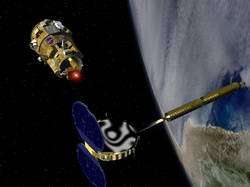NASA released a summary Monday of the findings about why its Demonstration of Autonomous Rendezvous Technology spacecraft did not complete its mission and collided with the intended rendezvous satellite on April 15, 2005.
Because the official mishap investigation board report contains information protected by U.S. International Traffic in Arms Regulations, it will not be publicly released. Instead, NASA has prepared a summary of the report, which omits the protected information. The summary is available at: http://www.nasa.gov/dart
This NASA craft was a low-cost, high-risk technology demonstrator, designed to establish autonomous rendezvous capabilities and proximity operations for the U.S. space program. It was successfully launched from Vandenberg Air Force Base, Calif., on April 15, 2005.
The spacecraft was to autonomously rendezvous with and perform a series of maneuvers in close proximity to a communications satellite no longer in use. The NASA spacecraft performed nominally during the first eight hours of the mission ― launch, checkout, and rendezvous phases. It accomplished all objectives up to that point, though ground operations personnel noticed some anomalies with the craft's navigation system.
During proximity operations, the spacecraft began using more propellant than expected. Approximately 11 hours into the mission, the craft detected its propellant supply was depleted and began a series of maneuvers for departure and retirement. Although not known at the time, it made contact with and boosted the rendezvous satellite's orbit 1.2 nautical miles higher. The rendezvous satellite was not damaged.
Both satellites are in low-Earth orbits that will not be a hazard to other spacecraft. They will eventually burn up upon re-entry into the Earth's atmosphere.
The spacecraft and the Pegasus launch vehicle were developed by Orbital Sciences Corp., Dulles, Va. NASA's Exploration Systems Mission Directorate funded the project.
The mishap investigation report was the result of an investigation by an eight-member board established by NASA on April 21, 2005. The summary of the report was produced by the Exploration Systems Mission Directorate.
Source: NASA
























